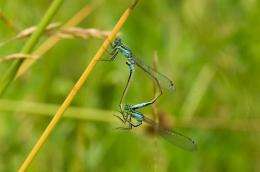Ability to tolerate enemies influences coevolution

Stay and fight, or flee? These are usually the alternatives facing a victim when it is attacked by an enemy. Two researchers from Lund University have now collected and discussed various examples from the animal world where the victim makes use of another possibility.
“The victim can allow the enemy to remain and instead try to live with the consequences”, explains Erik Svensson, Professor of Animal Ecology at Lund University, Sweden.
There are many examples of ‘coevolution’, i.e. where the enemy and the victim influence each other’s development in close interaction. In several plant studies it is for instance a relationship between a parasite (the enemy) and its host plant (the victim). Erik Svensson and his colleague Lars Rľberg have recently published an article in the journal Trends in Ecology & Evolution, in which they discuss the evolution of enemy-victim relations in animals.
The cuckoo’s brood parasitism is a classic example. The great spotted cuckoo lays its eggs in the nest of the European magpie and lets the magpie pair raise its young. The magpie can in turn respond by trying to recognise alien eggs and reject them; this is a form of resistance. However, there is a risk that the magpie may accidently reject one of its own eggs. In addition, the magpies that reject cuckoos’ eggs run a higher risk of having their nests destroyed by adult cuckoos. There is evidence that magpies that live in close proximity to great spotted cuckoos actually compensate for this by laying more eggs than magpies that breed in areas where cuckoos are not present. One reason for this could be that it is a way to compensate for the eggs that risk being destroyed. This defence tactic is classified as tolerance, rather than resisistance. It means that the victim tries to live with the presence of the enemy instead of resisting.
Erik Svensson conducts research on damselflies. He has shown that enemy-victim relationships can also occur within the same species. When damselflies mate, the male clasps the female’s thorax. Immediately after fertilisation, the female begins laying eggs. Yet females are constantly subject to mating attempts and harassment from other males, which incur costs in the form of a reduced number of eggs. However, some females have developed a higher tolerance to this mating harassment, which means that they are able to partly buffer the negative effects of mating harassment on their egg laying.
Lars Rľberg has studied tolerance in mice. He has performed an experiment in which he infected different mouse strains with malaria. It was apparent that the different mice did not become ill to the same extent, despite the fact that they had the same number of parasites in their bodies. Thus tolerance can also reflect itself in how sensitive a victim is to an enemy.
“This is a new way of viewing the evolution of enemy-victim interactions in animals. The role of tolerance in suchinteractions have previously been discussed primarily in the context of the plant world. We believe that tolerance could be at least as important as resistance in animal co-evolution between enemies and their victims”, says Erik Svensson.
Source: Expertanswer















